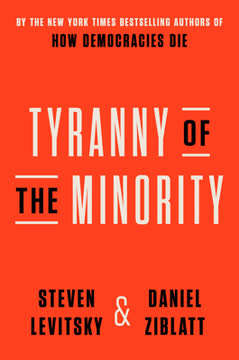Key Takeaways
1. The politics industry is a private enterprise within a public institution
Much of today's system is a self-serving, self-perpetuating private industry composed of gain-seeking actors who write their own rules.
Industry structure. The politics industry operates like any other business sector, with the Democratic and Republican parties forming a duopoly. This industry includes:
- Political parties
- Special interest groups
- Lobbyists
- Big-money donors
- Think tanks
- Media organizations
Dual currencies. The politics industry trades in two forms of currency:
- Votes
- Money
This dual currency system creates a power imbalance, with money often having greater influence than votes. The result is a system that prioritizes the interests of well-funded groups over those of average voters.
Self-regulation. Unlike other industries, politics lacks independent regulation. The Federal Election Commission, ostensibly an independent body, is effectively controlled by the two major parties. This self-regulation allows the industry to operate with little accountability to the public it purportedly serves.
2. Unhealthy competition in politics fails to serve the public interest
In today's political competition, then, serious legislation is often only passed under single party control.
Zero-sum game. Political competition has devolved into a win-lose scenario where:
- Parties prioritize defeating opponents over solving problems
- Compromise is seen as weakness
- Gridlock is often preferred to giving the other side a "win"
Customer neglect. In a healthy competitive environment, businesses strive to serve customers better. In politics:
- Average voters are largely ignored
- Special interests and donors receive preferential treatment
- Partisan primary voters wield disproportionate influence
Lack of accountability. The current system lacks mechanisms to hold politicians accountable for poor performance:
- Safe districts reduce electoral competition
- Party loyalty is rewarded over effective governance
- The duopoly structure prevents new entrants from challenging incumbents
3. Party primaries and plurality voting create barriers to new competition
Party primaries create an eye of the needle through which no problem-solving politician can pass.
Party primaries:
- Empower a small, often extreme subset of voters
- Force candidates to cater to partisan interests
- Discourage compromise and bipartisanship
Plurality voting:
- Allows candidates to win with less than 50% support
- Creates the "spoiler effect," discouraging third-party and independent candidates
- Leads to strategic voting rather than sincere preference expression
Combined effect:
These two elements of the election machinery:
- Raise barriers to entry for new competitors
- Reinforce the two-party duopoly
- Reduce voter choice and representation
4. The legislative machinery is designed to serve partisan interests
Congress has been carefully constructed to institutionalize partisanship and work against bipartisan solutions.
Partisan control: Key aspects of the legislative process are designed to reinforce party power:
- Committee assignments based on party loyalty
- The "Hastert Rule" allowing majority party leaders to block bipartisan bills
- Partisan staff and think tanks supplying policy ideas
Gridlock by design: The current system incentivizes:
- Obstruction over cooperation
- Messaging bills over substantive legislation
- Maintaining party unity at the expense of problem-solving
Loss of deliberative capacity: Congress has diminished its ability to address complex issues:
- Reduced committee hearings and expert testimony
- Cuts to nonpartisan research staff and agencies
- Increased reliance on partisan lobbyists for policy development
5. America's political dysfunction mirrors the Gilded Age crisis
Today, our shared challenge is to reform our political system to restore healthy competition in the public interest.
Historical parallel: The late 19th century Gilded Age saw:
- Extreme economic inequality
- Political corruption and party machine dominance
- Social upheaval and polarization
Progressive Era reforms: In response, reformers implemented:
- Direct primaries
- Secret ballots
- Initiative and referendum processes
- Direct election of senators
Contemporary crisis: Today's challenges echo the Gilded Age:
- Growing economic disparity
- Loss of faith in democratic institutions
- Technological disruption and social change
The success of Progressive Era reforms demonstrates that systemic political change is possible and provides a model for modern reform efforts.
6. Final-Five Voting can restore healthy political competition
Final-Five Voting will change the very nature of our elections. It realigns the incentives that drive the elected officials who lead us and it forces open the gates of our elections to new competition.
Two-part reform:
- Nonpartisan top-five primaries
- Ranked-choice voting in general elections
Benefits:
- Eliminates the spoiler effect
- Encourages more diverse candidates and ideas
- Rewards problem-solving over partisanship
- Increases voter choice and power
Implementation: Final-Five Voting can be adopted at the state level through:
- Ballot initiatives in states with direct democracy
- Legislative action in other states
Even adoption in a handful of states could create a critical mass of reform-minded legislators in Congress.
7. Reengineering legislative machinery is crucial for effective governance
To change the results our system delivers, we must change the rules of the game.
Zero-based redesign: The authors propose:
- Discarding existing rules and practices
- Reimagining Congress from scratch using best practices in negotiation, communication, and problem-solving
Key areas for reform:
- Committee structures and powers
- Debate and amendment processes
- Staffing and research resources
- Voting procedures
Potential outcomes:
- Increased bipartisanship and compromise
- More effective policy development
- Greater accountability to voters
Reforming legislative machinery is challenging but essential for translating electoral reforms into better governance.
8. Political innovation requires cross-partisan coalitions and local efforts
Keep It Cross-Partisan.
Building coalitions: Successful reform efforts require:
- Engagement from across the political spectrum
- Focus on process reform rather than partisan outcomes
- Emphasis on shared democratic values
Local leadership: Effective campaigns are:
- Rooted in local communities
- Led by committed state-based reformers
- Tailored to specific state political contexts
Four key constituencies:
- Grassroots volunteers
- Donors and civic leaders
- Political figures for credibility
- Opinion leaders for public education
Reform efforts must be prepared for pushback from entrenched interests and plan for long-term implementation battles.
9. Investing in political reform offers the highest return on investment
Political philanthropy offers the greatest potential return on investment available today.
Leverage effect: Improving the political system can unlock progress across multiple policy areas:
- Education
- Healthcare
- Infrastructure
- Economic development
Scale of impact: Government spending dwarfs philanthropic giving:
- Annual charitable donations: $410 billion
- Federal and state government spending: $405 billion every four weeks
Call to action: The authors urge:
- Philanthropists to redirect resources to political innovation
- Business leaders to support reform efforts
- Citizens to engage in local and state-level campaigns
Investing in political reform is not just about improving governance—it's about preserving and strengthening American democracy for future generations.
<words>2000</words>
Last updated:
FAQ
What's The Politics Industry about?
- Focus on Dysfunction: The book examines the dysfunction in American politics, attributing it to the two-party system and the political-industrial complex, which prioritize political actors over public interest.
- Call for Innovation: Authors Katherine M. Gehl and Michael E. Porter propose a framework for political innovation to break partisan gridlock and improve democracy.
- Historical Context: It draws parallels between current political challenges and those of the Gilded Age, showing how citizens have historically reclaimed democracy through reform.
Why should I read The Politics Industry?
- Timely Insights: The book provides insights into why many Americans feel unrepresented and frustrated with the political system, offering a fresh perspective on addressing these issues.
- Practical Solutions: It presents actionable solutions, such as Final-Five Voting, to reform the electoral process and enhance democratic participation.
- Engaging Writing: The authors' backgrounds in business and politics lend credibility to their analysis, and their clear writing makes complex political concepts accessible.
What are the key takeaways of The Politics Industry?
- Dysfunctional System: The current political system fails to serve the American people due to entrenched interests and unhealthy competition.
- Need for Innovation: Gehl and Porter advocate for innovative reforms to revitalize democracy, focusing on changing the rules to encourage healthy competition.
- Final-Five Voting: A central proposal, it combines nonpartisan top-five primaries with ranked-choice voting to enhance voter choice and accountability.
What is Final-Five Voting, and how does it work?
- Two-Part System: It consists of nonpartisan top-five primaries and ranked-choice voting in general elections, allowing the top five candidates to advance.
- Increased Voter Choice: This system provides more options and reduces the fear of wasting votes, encouraging candidates to appeal to a broader electorate.
- Eliminates Spoiler Effect: Ranked-choice voting ensures majority support, reducing the spoiler effect and promoting constructive campaigning.
How does The Politics Industry address the issue of partisanship?
- Partisan Gridlock: The authors argue that the system fosters division, making collaboration difficult and leading to public disillusionment.
- Historical Context: By drawing parallels to the Gilded Age, the book illustrates the cyclical nature of political challenges and the need for reform.
- Call for Unity: Gehl and Porter emphasize the importance of citizens coming together across party lines to demand change.
What are the main criticisms of the current political system discussed in The Politics Industry?
- Self-Serving Nature: The political-industrial complex prioritizes politicians and special interests over the public, undermining democracy.
- Ineffective Governance: Elected officials focus on re-election rather than solving problems, leading to inaction on pressing issues.
- Voter Disenfranchisement: Party primaries and plurality voting disenfranchise many voters, limiting competition and representation quality.
What historical examples do the authors use to illustrate their points in The Politics Industry?
- Gilded Age: The book references this period of significant political dysfunction, drawing parallels to today's challenges.
- Progressive Era Reforms: It highlights reforms like direct primaries and the direct election of senators as citizen-led successes.
- Case Studies: Examples from states like California and Maine demonstrate the potential for change through electoral reforms.
What are the best quotes from The Politics Industry, and what do they mean?
- “It’s the system.”: This phrase emphasizes that political dysfunction stems from the system's structure, not individual politicians, highlighting the need for systemic change.
- “Change the rules, change the game.”: It underscores the belief that altering electoral and legislative rules can lead to healthier competition and better political outcomes.
- “We must match our love of country with a system that’s designed to serve the people.”: This quote calls for a political system prioritizing public interest over partisan gain.
How do the authors propose to implement their reforms in The Politics Industry?
- Grassroots Mobilization: Emphasizing citizen engagement, the authors believe grassroots movements can push for electoral reforms.
- State-Level Initiatives: They advocate for state-level reforms, where citizens can influence change through ballot initiatives and legislative action.
- Building Coalitions: The book encourages forming cross-ideological coalitions to support political innovation and reform.
What are the potential challenges to implementing the proposed reforms in The Politics Industry?
- Resistance from the Duopoly: Entrenched interests of the two major parties may resist changes threatening their power.
- Public Awareness and Engagement: Widespread public understanding and support are crucial for reform success.
- Navigating Legal Barriers: Legal challenges and institutional inertia may hinder reform implementation, requiring strategic planning.
How does The Politics Industry suggest we can improve voter engagement?
- Innovative Voting Methods: The book advocates for ranked-choice voting and Final-Five Voting to enhance voter engagement and participation.
- Education and Awareness: Increasing public awareness about electoral reforms can motivate citizens to participate in the political process.
- Community Involvement: Encouraging local organizations to engage citizens in discussions about political reform can foster a sense of community and shared purpose.
How does The Politics Industry propose to address the issue of money in politics?
- Political Philanthropy: The authors advocate for investing in electoral reforms to improve governance and public policy outcomes.
- Regulation of Campaign Financing: They emphasize stricter regulations to reduce special interest influence and create a level playing field.
- Encouraging Small Donor Participation: By diversifying funding sources, candidates can become less reliant on large donors, leading to a more representative political system.
Review Summary
The Politics Industry receives mostly positive reviews, praised for its insightful analysis of the US political system as a duopoly and its proposed solutions. Readers appreciate the book's focus on systemic changes, particularly final-five voting and ranked-choice voting. Many find it hopeful and actionable, though some criticize its writing style and redundancy. The book is lauded for its non-partisan approach and historical context, with readers recommending it as an important read for understanding and potentially improving American democracy.
Similar Books










Download PDF
Download EPUB
.epub digital book format is ideal for reading ebooks on phones, tablets, and e-readers.




